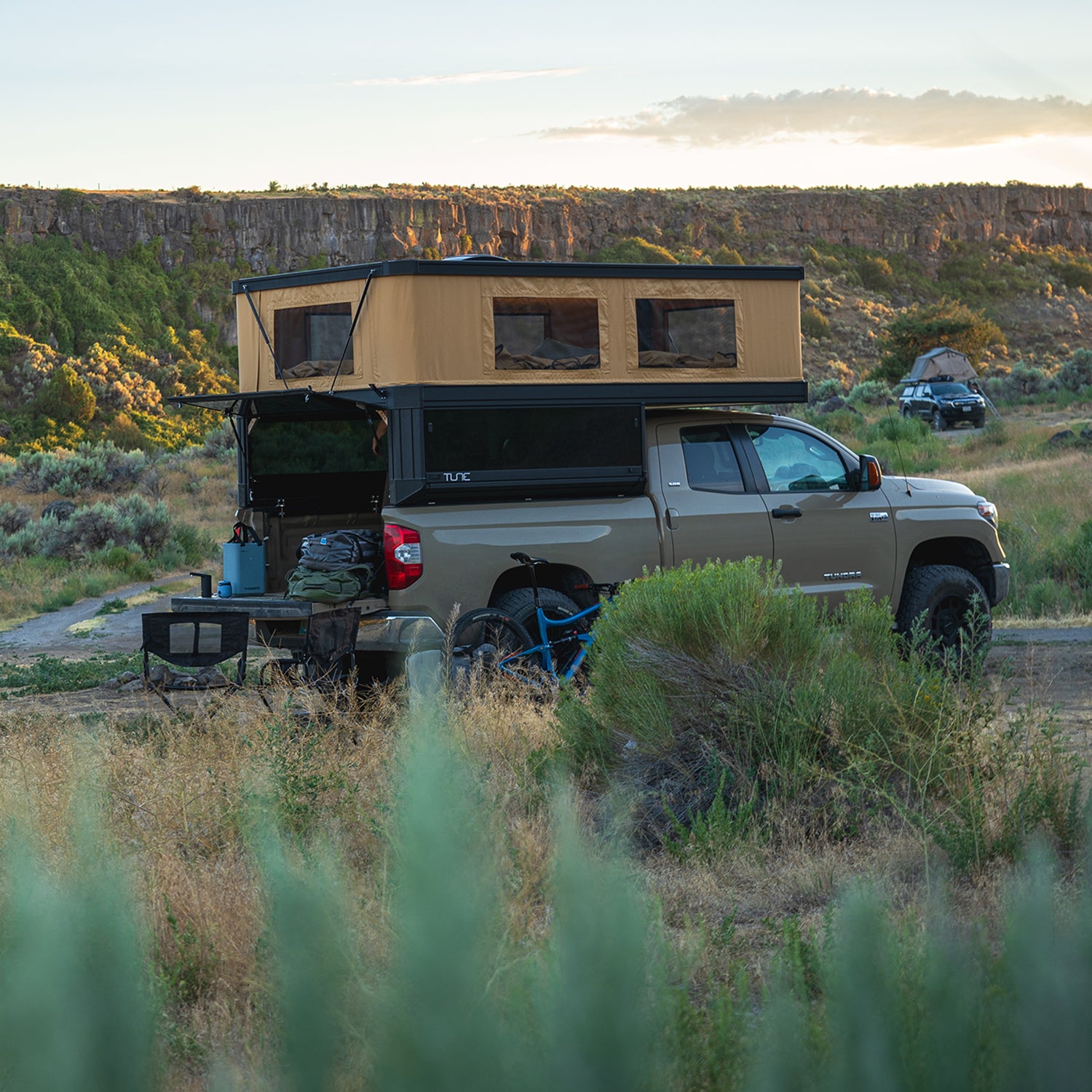There was a time when you had to choose between comfort and off-roading chops when it came to pulling your adventure home along with you. You could spend a week in a luxury trailer as far as the pavement would take you, or sleep off-kilter in a Jeep pop-up camper deep in the wild. Now, whether you chase your motor-powered thrills at a gravel campground or 500 miles from the nearest interstate, your options are better than ever.
Our favorite slide-in, pop-up, and tow-behind equipment of the year keeps your storage space usable, maximizes sprawl—yes, there’s a short-bed camper that fits a king-sized mattress—and promises as much off-road prowess as you can dream of.
Updated April, 2025: We added a new pick—the Wayfarer Vans Walt Conversion—to this list, and updated other pricing and product info throughout.
At a Glance
- Best Van Conversion: Wayfarer Vans Walt Conversion (From $25,00)
- Best Minimalist Camper: Tune Outdoor Tune M1 (From $12,999)
- Best Off-Road Trailer: Boreas Campers EOS-12 (From $84,990)
- Best Luxury Rig: Airstream Trade Wind (From $129,400)
- How to Choose a Trailer or Camper
- How We Test
- Meet Our Lead Testers
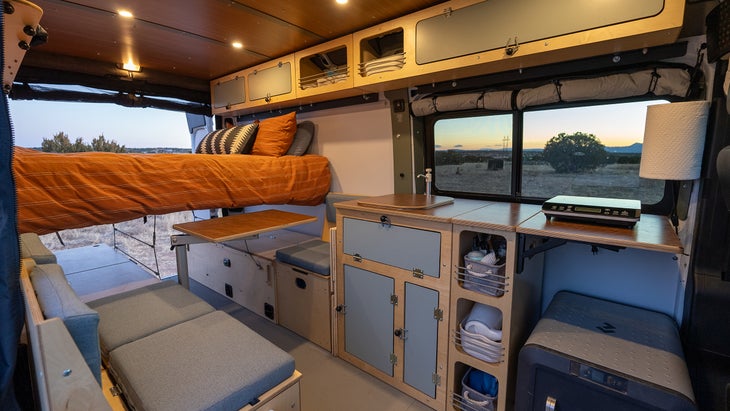
Best Van Conversion
Wayfarer Vans Walt Conversion
Type: Van Conversion
Material: Laminated composite wall and ceiling panel; Havelock wool insulation; 9-ply solid-core baltic birch plywood
Pros and Cons
⊕ Simple, high-quality build
⊕ Modular layouts
⊕ Will convert used vans
⊕ 2-3 day install time
⊗ Conversions only available for Ram Promaster and Ford Transit
⊗ No custom work
Watch: Inside Look at the Wayfarer Walt Van Conversion
Van conversion companies are a dime a dozen these days. The vast majority offer expensive, fully custom buildouts loaded with complicated electrical and plumbing systems that can easily cost six figures—sometimes even without factoring in the price of the van itself—and take weeks, if not months, to build.
That’s not the case with Colorado Springs-based Wayfarer Vans: their largest conversion, built on a 159” High Roof Ram Promaster cargo van platform, starts at $25K. While that price can climb to around $55K if you add every optional accessory possible, like a 12V air conditioner, bug screens, 400 watts of solar, and a Propex Heater, it’s still an incredible value in today’s campervan marketplace. Wayfarer also completes the installation in just 2-3 days.
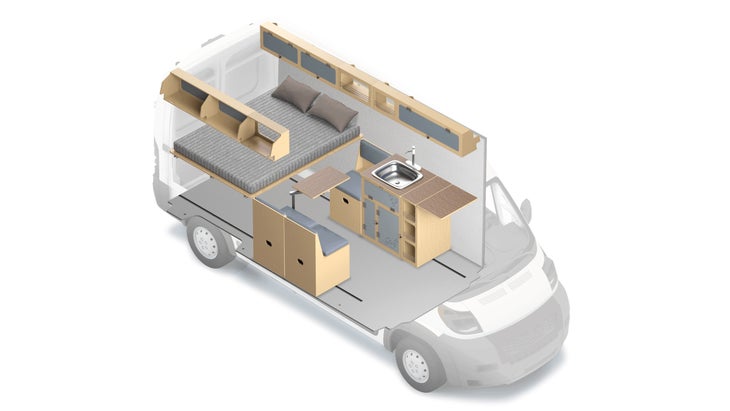
The value is what originally caught our attention, but what stood out during a multi-week test last summer was the quality and functionality. There’s tons of storage space for gear throughout, and the Baltic Birch cabinets and furniture felt solid and didn’t rattle loose—even after we drove on miles of washboard roads in Montana. A simple hand pump and removable, five-gallon fresh and grey water containers meant we didn’t worry about built-in tanks leaking or accidentally leaving the water pump on while out fishing for the day.
An over-bed shelf with bungees kept things like extra layers and blankets out of the way without adding the additional weight of more cabinets. The built-in, insulated partition that separates the cab and living area made for a great privacy screen while changing at trailheads, and quickly rolled up and out of the way during travel.
We also loved the modular interior: all the furniture simply bolts into cargo track on the floor, which meant we could move things around to accommodate multiple bikes and other bulky items. Most other vans with modular interiors we’ve tested feel more like camping in a mobile erector set, whereas the Walt felt like a cozy, minimalist cabin with the added benefit of modularity. It’s the perfect blend of #vanlife and practical work van functionality.
Despite the reasonable price point, the brand still uses proven, premium materials throughout, like Havelock Wool insulation, 9-ply solid-core Baltic Birch plywood, and laminated composite wall and ceiling panels. Translation? They’re built for the long haul, and you’d be hard-pressed to find a better-built, more adaptable, and well-thought-out campervan for the money.
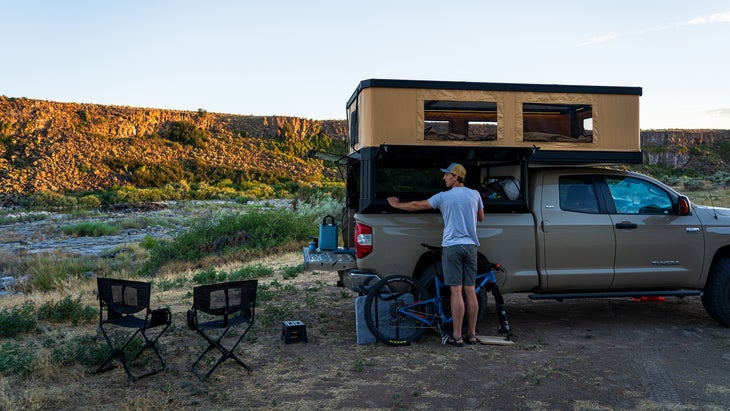
Best Minimalist Camper
Tune Outdoor Tune M1
Type: Canopy-style popup truck camper
Weight: From 387 lbs (short-bed Tacoma)
Material: Aluminum/Composite
Pros and Cons
⊕ Incredible space-to-weight ratio
⊕ Sleek
⊕ Retains bed utility
⊗ Heavier than some wedge campers
⊗ Expensive
Watch: Tour of the Tune M1 Truck Camper
True innovation has been tough to come by in the lightweight, shell-style truck camper market lately, but that changed when Denver-based Tune Outdoors launched its Tune M1 in 2023.
Instead of releasing just another wedge camper or traditional slide-in, Tune combined some of the best existing features on the market, like building with aluminum extrusions and honeycomb composite panels, and added its own twist: The Tune M1 rests on a truck’s bed rails, but the side walls flare out at the bottom to provide far more interior living space than anything else out there. That extra width also provides more standard sleeping space—in fact, an optional bed extension platform accommodates a nearly king-sized mattress on a short-bed Tacoma.
The Tune M1’s starting price includes features that cost extra at many other brands, like built-in lighting, a 4-inch memory foam mattress, and 440-plus feet of T-Track. All that T-Track means you can bolt nearly anything to the camper, and easily build out the interior if you wish.
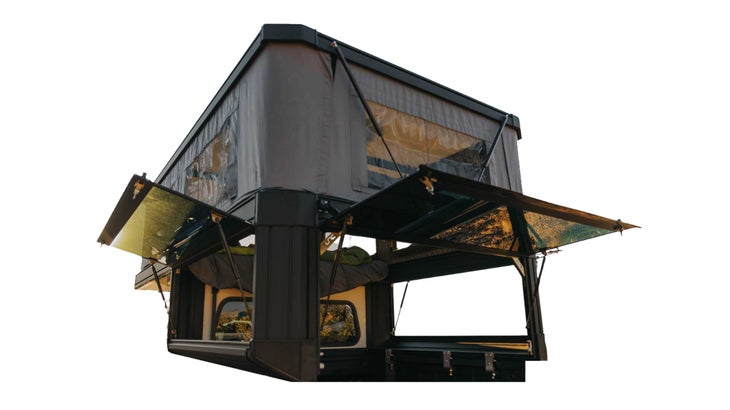
Bonus: Side awning panels fully open for gear access. Our favorite option is the tempered glass side panels, which not only look fantastic, but also let more light inside and allow for panoramic views. “The packed-down silhouette is so tight that we never held back on even the burliest roads,” says Aaron Gulley, a longtime Outside contributor and gear tester. “But it has so much popup space that the truck bed felt roomy for two people even with coolers, a generator, and requisite camping gear.”
The perfect cross between a fully featured slide-in and a wedge camper, the Tune M1 is ideal for families who need more space, or anyone who wants a truck camper but also wants to continue using their truck bed for truck things.
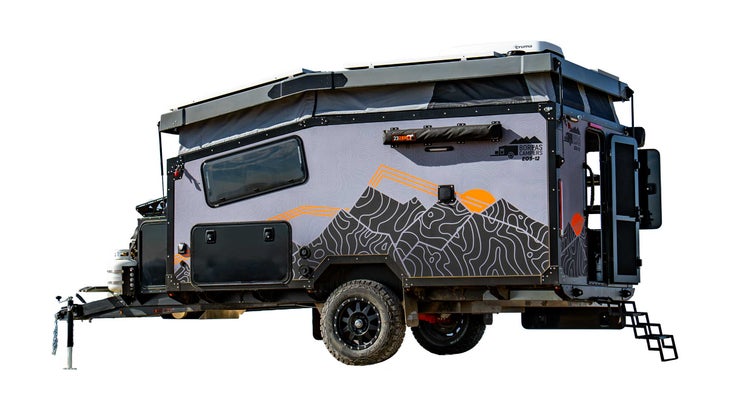
Best Off-Road Trailer
Boreas Campers EOS-12
From $84,000 at Boreas Campers
Type: 4-Season off-road travel trailer
Material: Composite and metal construction
Weight: 3,750 lbs (dry weight)
Pros and Cons
⊕ Incredibly capable off road
⊕ No-wood construction (no mold, rot, etc.)
⊕ 50-gallon fresh water capacity
⊗ Expensive
⊗ No indoor sink/cooking option
Watch: Inside the Boreas EOS-12 Trailer
We’ve followed Pueblo, Colorado-based Boreas Campers closely since it debuted its AT and XT models, both class-leading off-road teardrops, a few years ago. The EOS-12 builds on the solid foundation of those campers and takes everything to a new level—literally.
The EOS-12 is a 20-foot, overland-style pop-up travel trailer built to go anywhere and keep you comfortable off-grid for extended periods of time in any weather conditions. Composite panel construction keeps the rig well insulated and light on its feet with a dry weight of 3,750 pounds.
The trailer features a slim canvas pop top that keeps it aerodynamic, a well-appointed outdoor kitchen, and a full indoor wet bath. With one queen-sized main bed and a dinette that folds out to about a twin sized bed, we found it could sleep three adults comfortably, and appreciated the copious amounts of storage inside.
The EOS-12 really shines when it comes to its mechanical and electrical features. It rides on a Cruisemaster XT—an independent trailing arm suspension with airbags and auto-level, capable of handling much rougher terrain than you’re likely to experience—540 amp hours of Battleborn lithium batteries, Victron electrical components, and 400 watts of solar panels.
Everything on this camper, from the exterior rock lights to the air compressor and the furnace, are operated by a portable Garmin O.N.E. tablet, which, despite our initial hesitation, performed flawlessly.
“We loved using the EOS-12 on a 5-day mule deer hunt,” says Eric Ladd, a mountain biker, hunter, skier, and all-around adventure seeking ER doc based in Santa Fe, NM. “We never worried about where we were towing it, it didn’t come close to running out of power or water, and we ate like kings thanks to the amazing outdoor kitchen—despite being off grid the entire time.”
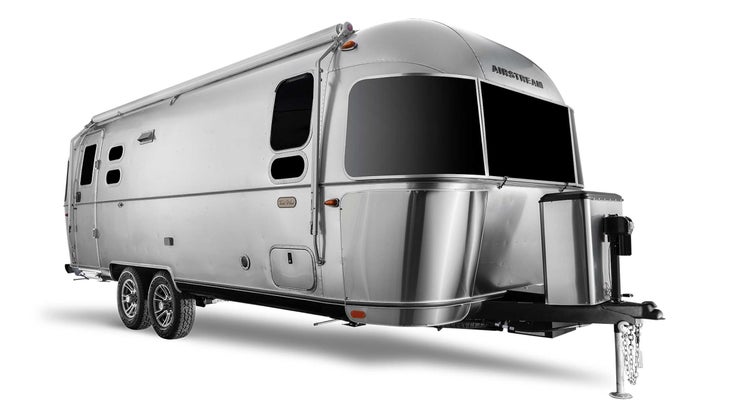
Best Luxury Rig
Airstream Trade Wind
Type: Travel Trailer
Material: Aluminum
Weight: 6200 lbs (dry weight)
Length: 25’ 2”
Pros and Cons
⊕ Fully off-grid power system
⊕ Gorgeous interior design
⊕ Roomy floor plan
⊗ Expensive
⊗ Not as off-road-capable as others
Watch: Tour the Airstream Trade Wind Trailer
The reintroduction of the Trade Wind model shows that Airstream is listening to consumers. While the Basecamp models have been marketed towards younger generations looking to get a little further off the beaten path, the Trade Wind is the first of the company’s iconic, silver bullet-shaped travel trailers to come off the factory floor with everything a boondocker needs—and, as it turns out, everything our testers have added to their personal Airstreams.
It comes with a robust solar system, Battleborn lithium batteries, a 3-inch lift kit and all-terrain Goodyear Wrangler Workforce Tires. When you combine the system upgrades with a stellar floor plan that sleeps up to five, gorgeous interior design, and other smart features like a recirculating water heater, optional composting toilet, and an optional rear hatch that lets you easily load bulky gear, it all adds up to an incredible, luxurious, off-grid basecamp.
“We have owned an Airstream for nearly a decade and modified it for heavy, backcountry, boondocking use. The new Trade Wind is everything we always wanted ours to be—and much more,” said Gulley. “This is a rig built to go anywhere and do everything, and to do it in classic Airstream style. We definitely see an upgrade in our near future.”
How to Choose a Camper or Trailer
Buying a camper of any kind is a big investment, so it’s best if you can try one out or at least see one in-person before pulling the trigger. Visiting a dealer is great, but a lot of today’s best rigs are sold direct-to-consumer, which means that events like Overland Expo are a great way to see a camper up close.
Even better, try renting the type of rig that interests you on Outdoorsy to get a real feel for it. Even if they don’t have the specific model you’re looking for, you’ll get an idea of whether you’re a van, trailer, or truck camper person.
What Kind of Camper Should I Buy?
The short answer is, it depends. In general, we think most folks are better served by buying a tow-behind they can pull with their current vehicle. Trailers have more space than a van or truck camper could ever provide, and they don’t have engines, transmissions, and other expensive parts to maintain.
How Much Should I Expect to Spend?
For a new rig, you should budget anywhere from $100-250K for a van, $10-30K for a truck camper (sans truck), and $30-130K for a trailer, depending on your tastes and needs.
How Much Solar Do I Need?
It all depends on how much luxury you want off grid. For most weekenders, around 200-300 watts of solar and 100-200 amp hours of lithium batteries will be more than enough.
How We Test
- Number of testers: 6
- Nights Spent Camping: Over 20
- Number of campers/trailers tested: 7
- Longest Stint Spent Off-Grid: 7 days
- Most Challenging Test Drive: 23 miles of rugged, New Mexico washboard
Between attending overland expo shows to tour the latest rigs and testing demo trailers on extended trips, category manager Bryan Rogala spends over 30 nights camping in everything from rooftop tents to Airstreams every year.
Because evaluating adventure rigs isn’t as simple as testing a pair of running shoes, our testing criteria looks a bit different. We look at build quality, standard features and components, pricing, and availability, as well as details like trailer suspension and camper wall construction methods, in an effort to find a broad array of what we think are the most well-made and value-driven rigs on the market.
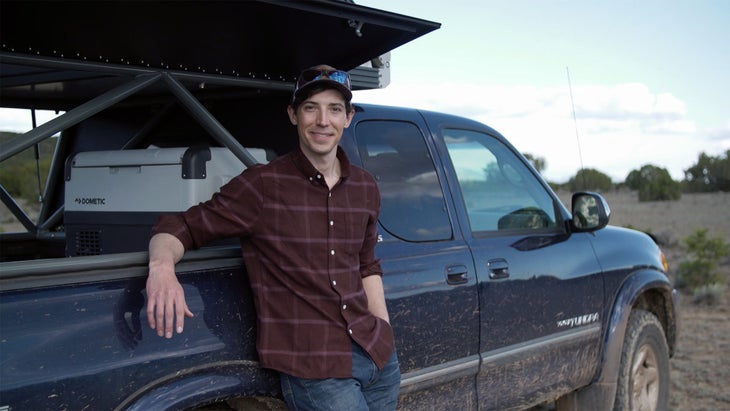
Meet Our Lead Testers
Bryan Rogala is a longtime contributor to Outside and has been reviewing trailers and campers since 2018. He covers overlanding gear and rigs in his regular column, and his 101 video series for Outside Online. As a hunter, mountain biker and skier, he’s in a constant search for the perfect adventure rig.
Aaron Gulley and Jen Judge, both former Outside contributors and gear testers, spent 3.5 years living full-time in their 2014 Airstream Flying Cloud 23FB. Their travels as cyclists, hikers and hunters have taken them and their Airstream all around the U.S., and provided serious insight into the world of travel trailers.
Corey Leavitt is a filmmaker, truck nerd, and adventure rig enthusiast. He’s filmed and helped produce all of Rogala’s 101 videos, rehabbed a truck camper, and spends more time on Craigslist seeking the next rig than anyone should.
Eric Ladd is a mountain biker, hunter, skier, and all-around adventure seeking ER Doc. He’s modified his own travel trailer for off road and off grid use, and takes his young family of four camping all over the Western U.S.
More Gear Reviews
The Best Tents for Camping in Comfort and Style
The Camp Kitchen Gear Our Testers Swear By
11 Pieces of Camping Gear that Aren’t Essential but Are Really Nice to Have


